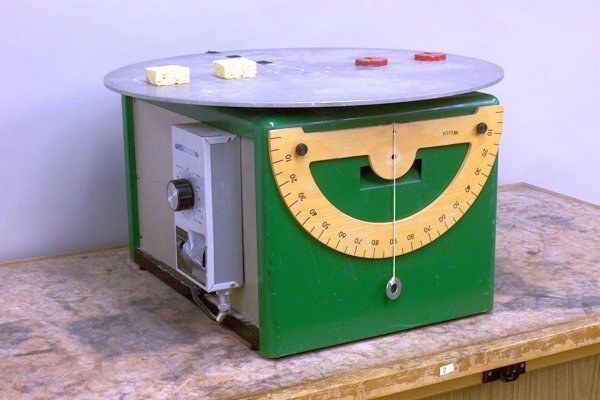

Place either the sponges or the metal slugs, or both, on the turntable. As you increase the speed, you reach a point where the masses begin to slide. You can compare the speeds at which slippage occurs for masses closer to the center or to the edge, and between the sponges and the metal slugs. You can also tilt the turntable until a mass begins to slide, read the angle of tilt from the protractor, and determine the coefficient of friction.
For an object to move in a circular path, it must experience an acceleration perpendicular to its velocity, or a centripetal acceleration. (See demonstration 16.03 – Ball on turntable.) The force necessary to provide this acceleration – the centripetal force – equals mv2/r, where m is the mass of the object, v is its tangential velocity, and r is the radius of the circle in which it is moving. This force can come, for example, from tension in a string or rope (see demonstration 16.06 – Twirl ball(s) on string), or from the normal force provided by a curved track (see demonstration 16.09 – Roll ball into C frame, or demonstration 16.33 – Loop the loop). In this demonstration, friction between the various masses and the turntable provides this force.
Friction opposes the motion of two surfaces relative to each other. It is proportional to the normal force between the two surfaces, and the proportionality constant, μ, the coefficient of friction, depends on the characteristics of the particular surfaces, essentially, how smooth or rough they are. (See demonstrations 12.66 – Pull friction block with spring scale, and 12.69 – Slide blocks down incline.) For a mass resting on a surface, this force equals μmg, where m is the mass, and g is the acceleration of gravity (9.80 m/s2). Thus, to keep the masses moving in a circle without sliding, μmg must equal mv2/r. Since the mass appears on both sides of the equation, it cancels, and we find that μg = v2/r. If you increase v, when you reach the point at which v2/r exceeds μg, the masses begin to slide outwards. All the masses have the same v/r (= ω, the angular speed of the turntable), but v2/r is greater for the masses farthest from the center, so the outer masses should begin to slide before the inner masses. This is, indeed, what you observe if you perform this demonstration. In fact, if the inner masses are too close to the center, the turntable cannot spin fast enough for v2/r to exceed the friction, and the masses stay put.
If you wish to measure the friction, you can tilt the turntable, and by means of the attached protractor, measure the angle at which the slugs and sponges begin to slide. (Because of the orientation of the protractor, the angle, θ, equals 90 degrees minus the protractor reading.) μ = tan θ (see demonstration 12.69 – Slide blocks down incline). Then, if you place the masses at known r, you can calculate the speed of the turntable at which the masses slide by v = √(μgr) and ω = v/r.
Alternatively, you can place a mass at a particular radius (measured, say, with a meter stick) and find the speed at which the mass begins to slide. Then, after marking the spot (with chalk or a piece of tape), you can measure the speed by timing the number of revolutions of the spot per second. The tangential speed of the spot, v, then, is the number of revolutions per second multiplied by 2πr, and μ = v2/rg.